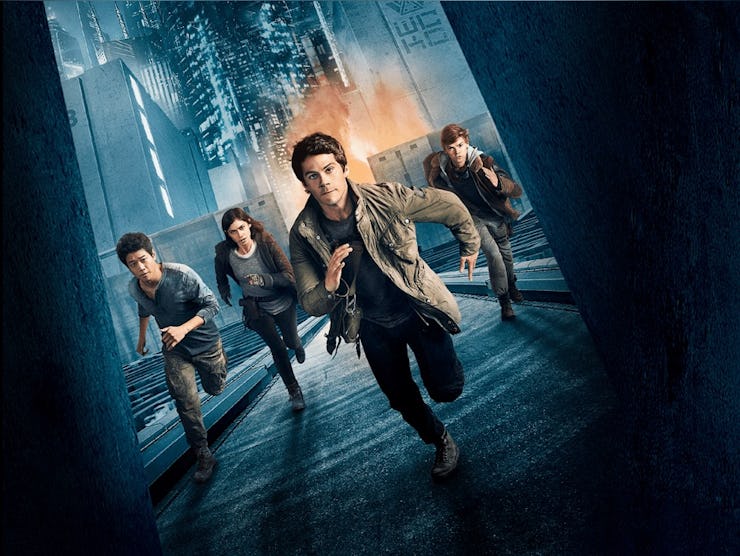Maze Runner: The Death Cure helped kill the YA dystopia. Can it help revive the genre too?
“Just follow me and run like your life depends on it. Because it does.”

The Maze Runner had so much working for it.
Teen heartthrob looks and genuine talent in its star, Dylan O’Brien? Check. A strong supporting cast that included Skins veteran Kaya Scodelario and Breaking Bad breakout Giancarlo Esposito? Also check. Genuinely impressive visual effects, from the sterile techiness of the villain’s headquarters to the horrifying zombification of the Flare virus’ victims? Checks all around!
Combined, these aspects sold the post-apocalyptic teenage hell envisioned by Maze Runner author James Dashner and director Wes Ball, which pitted teens against a flurry of lethal cyborg monsters in a bevy of dangerous mazes meant to study the physical makeup of brains immune to a disease that had ravaged society.
But this wasn’t enough to keep The Maze Runner film franchise going. The Orwellian survivalist game met an untimely and premature end with The Death Cure in 2018, as producers opted to take an indefinite pause on movie adaptations of the fourth and fifth books rather than seeing the maze all the way through. So what happened?
The Maze Runner came to a crashing halt
Despite its many positive qualities, The Maze Runner had some glaring issues right from the get-go. For one, it made it to theaters to serve as an answer for all of two white leading ladies in the YA dystopia boom — Shailene Woodley’s Tris in Divergent and Jennifer Lawrence’s Katniss in The Hunger Games — and banked on being a blockbuster franchise where guys dominated the screentime.
The problem was that, by the mid-2010s, people of all ages were actually hungry to see girlbosses slay in post-apocalyptic narratives. As such, audiences were less keen on the likes of Scodelario’s scantily characterized anti-heroic deuteragonist, Teresa, who remains despicable until the bitter end of The Death Cure. While Divergent and The Hunger Games appealed to a general audience, The Maze Runner made it clear from the start that it was only interested in carving out a space in the genre for male viewers.
The films’ casts were consistently stacked... until all its heavyweights were inexplicably killed off.
The second issue wasn’t the fault of its cast or crew, but time was not on this franchise’s side. The desire to watch teens run, hunt, fight, and politick for their lives in dilapidated versions of Chicago, Denver, and New York City began to wane after the epic finale of The Hunger Games trilogy in 2015, and it wasn’t because everything that needed to be said or shown about dystopias catering to a younger crowd had been exhausted. Rather, consumers of these books and films weren’t teenagers anymore, and they were finding new stories to consume.
The Death Cure came out too late, on January 26, 2018, marking the end of the YA sci-fi obsession with more of a whimper than a bang. Initially slated to release at the start of 2017, the third installment’s debut was delayed by almost 18 months due to injuries sustained by O’Brien on set, which shut down production for almost an entire year.
The Death Cure was succeeded by other post-apocalyptic one-off flops that same year — Mortal Engines, The Darkest Minds, and even Steven Spielberg’s forgettable Ready Player One — all collectively serving as a strong indicator that the 2010s YA dystopia boom had naturally run its course. But are we about to see a resurgence?
You deserved better, Kaya Scodelario.
Are we ready for a return to YA dystopia?
When The Maze Runner’s first volume was released in theaters, critics bemoaned the “silly” premise of human life purposefully being taken for granted and exploited to mitigate the effects of a rampant virus. Watching the movie trilogy eight years after it began, in a world divided by the proliferation of anti-science and pro-individualist attitudes, The Maze Runner doesn’t seem nearly as ludicrous as it once did.
With the popularity of HBO’s The Last of Us, which features a teen lead, as well as the forthcoming Hunger Games prequel The Ballad of Songbirds and Snakes, it seems like the time is nigh for a new age of YA dystopia. Will The Maze Runner make the cut as a franchise worthy of a reboot, prequel, sequel, reinvention, or re-imagination? Back in 2019, after Disney’s acquisition of 21st Century Fox, it was hinted that fans would get more Maze Runner, but in what form that franchise continuation would take place, no one could say.
Looking back on the dystopia flicks that comprised most of Gen Zers’ and Millennials’ ticket sales in the 2010s, the box office (and streaming) future for the genre looks promising. Hey, if you’re worried about the present, you might pine for the problems of a fictional future.
The Maze Runner: The Death Cure is available now on Hulu.